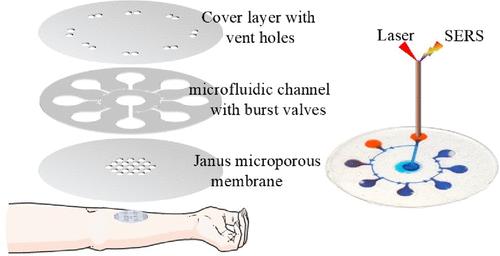脱体SERS分析的时间分辨汗液收集:桥接耐磨性和敏感性
IF 9.1
1区 化学
Q1 CHEMISTRY, ANALYTICAL
引用次数: 0
摘要
汗液携带着丰富的生理信息,是无创健康监测的理想选择。表面增强拉曼散射(SERS)能够对汗液生物标志物进行高灵敏度、多路检测,但由于拉曼光谱仪和激光源体积庞大,将其集成到可穿戴系统中仍然不切实际。为了解决这一限制,我们开发了一种可穿戴平台,专注于原位汗液收集和时间序列存储,实现延迟的、离体的高灵敏度SERS检测。该系统集成了一个具有润湿性梯度的Janus微孔膜,通过飞秒激光烧蚀和氧等离子体蚀刻制成,可以实现定向和连续的皮肤汗液收集。这与一个包含爆裂阀的微流控芯片相结合,可以在运动过程中进行被动的、按时间顺序的采样和汗液存储。为了检测,使用银镜像反应制备了基于毛细管的SERS底物,对乳酸钠和尿素的检测限低至1 mM。从人体汗液样品中清晰地识别出特征峰。这项工作为可穿戴式汗液传感与高性能光谱分析相结合提供了一条可行的途径,在个性化健康监测和动态生理评估方面具有广阔的应用前景。本文章由计算机程序翻译,如有差异,请以英文原文为准。

Time-Resolved Sweat Collection for Off-Body SERS Analysis: Bridging Wearability and Sensitivity
Sweat carries a wealth of physiological information and is ideal for noninvasive health monitoring. Surface-enhanced Raman scattering (SERS) enables highly sensitive, multiplexed detection of sweat biomarkers, but its integration into wearable systems remains impractical due to the bulky nature of Raman spectrometers and laser sources. To address this limitation, we developed a wearable platform that focuses on in situ sweat collection and time-sequenced storage, enabling delayed, off-body high-sensitivity SERS detection. The system integrates a Janus microporous membrane with a wettability gradient, fabricated via femtosecond laser ablation and oxygen plasma etching, to achieve directional and continuous sweat collection from the skin. This is combined with a microfluidic chip containing burst valves that enable passive, time-sequenced sampling and storage of sweat over the course of exercise. For detection, a capillary-based SERS substrate was fabricated using a silver mirror reaction, achieving detection limits down to 1 mM for sodium lactate and urea. Characteristic peaks were clearly identified from human sweat samples. This work presents a feasible path for combining wearable sweat sensing with high-performance spectroscopic analysis, offering promising applications in personalized health monitoring and dynamic physiological assessment.
求助全文
通过发布文献求助,成功后即可免费获取论文全文。
去求助
来源期刊

ACS Sensors
Chemical Engineering-Bioengineering
CiteScore
14.50
自引率
3.40%
发文量
372
期刊介绍:
ACS Sensors is a peer-reviewed research journal that focuses on the dissemination of new and original knowledge in the field of sensor science, particularly those that selectively sense chemical or biological species or processes. The journal covers a broad range of topics, including but not limited to biosensors, chemical sensors, gas sensors, intracellular sensors, single molecule sensors, cell chips, and microfluidic devices. It aims to publish articles that address conceptual advances in sensing technology applicable to various types of analytes or application papers that report on the use of existing sensing concepts in new ways or for new analytes.
 求助内容:
求助内容: 应助结果提醒方式:
应助结果提醒方式:


